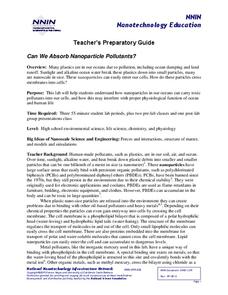Science 4 Inquiry
Eukaryotic Cells: The Factories of Life
Eukaryotes include humans, animals, and plants. Scholars learn about the parts of eukaryotic cells. They design models of a store and match the correct function of each part to the function of a part of the cell. They review their...
Curated OER
Semipermeable Membranes and Bioaccumulation
Beginning biologists place a drop of food coloring into water of differing temperatures to observe the effect on the diffusion rate. They remove the shells from raw eggs and then experiment with osmosis over the remaining membranes....
Teach Engineering
Cell Celebration!
Are you eukaryotic? (Answer: Yes.) The first of six installments in the Cells units teaches pupils about the similarities and differences of prokaryotes and eukaryotes. It also covers the functions of various cell components in both...
Curated OER
Cells - The Basic Unit of Life
Introduce students to cells, and their many parts in this biology presentation. Students see that plant and animal cells have many of the same type of structures, but also have many differences as well. They will be challenged to state...
Curated OER
Cell Division: Frog Egg Division Observation and Modeling
Students create and test a hypothesis about cell division. After observation of Frog Egg cell division, students write obervations and refine process and hypothesis. The use of scientific method, group work and inquiry are fostered by...
Teach Engineering
Cell Membrane Experimental Design
Grandma said to gargle with salt water for a sore throat. Was she right? In the last part of the seven-part unit, lab groups design an experiment to test a cells reaction to salt solutions. The pupils conduct their experiment to answer...
Curated OER
Cell, Socks, and Sex
Donate old socks for science! Young biologists model mitosis and meiosis, using socks as chromosomes and a balloon as a nucleus. This ingenious idea for modeling cell division will be more memorable to your young biologists than any set...
Curated OER
Movement Across the Membrane (Diffusion)
Students investigate the concept of diffusion and how materials enter and leave a cell. In this movement across a membrane lesson plan, students use perfume, food coloring in water and a sugar cube in water to observe diffusion. They...
Alabama Learning Exchange
Edible Cell
Students identify cell parts and their function. For this animal cell lesson, students view a video clip and discuss cell components. Students create an edible replica of an animal cell using food items.
Odell Education
Plant and Animal Cells
Incorporate multiple facets of the cell into your next high school lab! Through an introduction to cell organelles, class members observe each cell type and draw visuals to further demonstrate understanding of cellular processes in both...
Nuffield Foundation
Observing Osmosis, Plasmolysis, and Turgor in Plant Cells
Create the perfect conditions for osmosis. Young scholars use a microscope to observe plant cells exposed to distilled water or sodium chloride. They observe how osmosis creates turgid or plasmolyzed cells.
Curated OER
Plasmolysis in Elodea Plant Cells
Young scholars microscopically observe various subcellular components. They determine the effects of different salt solutions on Elodea plant cells. They detect the presence of chloroplasts, cell walls, and cell membranes of Elodea.
Curated OER
ACTIVE TRANSPORT ACROSS THE PLASMA MEMBRANE
Students comprehend that energy is required to move substances across the cell membrane against the concentration gradient.
Curated OER
Onion Cells
Learners observe the cells of an onion by wet mounting it and viewing it in a microscope. In this hands on lesson students make their own wet mount slide of an onion and are able to identify the cells in it such as, the nucleus,...
Curated OER
Acting Potential
Students set up a cell membrane with the material provided by their teacher and then arrange beads properly to show how the sodium and potassium ions are arranged. They then make a model representing the axon of a neuron.
MOST
What Are Cells?
What's in a cell, anyway? Kids read informational text on what makes up both animal and plant cells, including a page of vocabulary terms they will need to be familiar with (cytoplasm, ribosomes, vacuoles, etc.). Full-color images make...
Teach Engineering
Active and Passive Transport: Red Rover Send Particles Over
I can move about freely, but you cannot. The class models the movement through cell membranes by way of passive and active transport. Members of the class play the roles of various proteins, atoms, compounds, and cell actions and mimic...
Curated OER
WET Science Lesson #5: Pass the Salt Please! (How Road Salt Affects Wetlands)
As an anticipatory set, biologists listen to the story of Ruth Patrick, a scientist who used algae to detect water quality. They observe a demonstration of osmosis and diffusion. In their lab groups, they place Elodea stalks in...
Curated OER
Animal Cell Diagram
In this animal cell diagram worksheet, students are to draw a cell in the blank space and label it using words in the word bank. No information is given about what the cell would look like.
Curated OER
Cell Structure and Function
Tenth graders define and identify the cell membrane functions and structures. They study cell membrane properties" lipid bilayer" and explore cells under the microscope. They draw what they see, label any parts they can identify, and...
National Nanotechnology Infrastructure Network
Can We Absorb Nanoparticle Pollutants?
Just because we can't see it doesn't mean it isn't there! A growing concern for environmental scientists is toxic nanoparticles in our air and water. Young scholars conduct an experiment to demonstrate how these particles can cross our...
Curated OER
Cell Structures
Students differentiate between a prokaryotic and eukaryotic cell and give examples of both types. They differentiate between a plant and animal cell. Students will be able to name features common to both as well as unique features of each.
Curated OER
Cell Structures and Functions
Fifth graders search into animal and cell characteristics and their functions in this seven lesson unit. Replicas of the cell are constructed out of Jell-O as students probe the internet for details of the concepts.
Grand Erie District School Board
Model Cell Project
If you're finishing up a unit on cells, here's a great project to get kids collaborating and recalling what they've learned in a fun and tangible way. Small groups create plant or animal cells out of materials they have at home. They use...
Other popular searches
- Analogies for Cell Membrane
- Cell Membrane Egg Vinegar
- Cell Membrane Transport
- Cell Membrane Structure
- Cell Membrane Pictures
- Cell Membrane Model
- Bubbles Cell Membrane
- Cell Membrane Permeability
- Permeable Cell Membranes
- Cell Membrane and Diffusion
- Cell Membrane Lesson Plan
- Cell Membranes and Transport

























